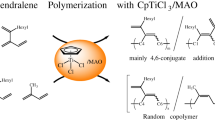Summary
The π-allylnickel-catalyzed coordination cyclopolymerization of a bis(allene) possessing a malonate moiety, diethyl bis(2,3-butadienyl)malonate, gave a polymer which is soluble in organic solvents. The polymer was composed of an almost comparable content of the 1,2- and the 2,3-polymerized units. The polymerization was supposed to proceed through the selective formation of a six-membered ring unit in the main chain by means of the cyclopolymerization of the bis(allene). That is, the intramolecular attack of the growing allylnickel species generated from the first allene moiety upon another one was supposed to give the 1,2-polymerized unit having the six-membered ring system while the intermolecular attack of the allylnickel species derived from the second allene provides the 2,3-polymized unit selectively as is the case of the monofunctional allenes. The effect of the polymerization conditions such as the concentration of the monomer on the polymerization behavior is also described.
Similar content being viewed by others
References and Notes
Butler GB, (1992) Cyclopolymerization and Cyclocopolymerization. Marcel Dekker, New York
(a) Fox HH, Wolf MO, O’Dell R, Lin BL, Schrock RR, Wrighton MS (1994) J Am Chem Soc 116:2827 (b) Fox HH, Schrock RR (1992) Organometallics 11:2763 (c) Hatakeyama T, Kamada M, Satoh T, Yokota K (1998) Macromolecules 31:2889 (d) Jayaratne KC, Keaton RJ, Henningsen DA, Sita LR (2000) J Am Chem Soc 122:10490
(a) Taguchi M, Tomita I, Yoshida Y, Endo T (2000) Macromol Chem Phys 201:1025 (b) Taguchi M, Tomita I, Yoshida Y, Endo T (1999) J Polym Sci Part A Polym Chem 37:3916 (c) Tomita I, Ubukata M, Endo T (1998) React Funct Polym 37:27 (d) Takagi K, Tomita I, Nakamura Y, Endo T (1998) Macromolecules 31:2779 (e) Takagi K, Tomita I, Endo T (1998) Macromolecules 31:6741 (f) Tomita I, Kondo Y, Takagi K, Endo T (1995) Acta Polymer 46:432 (g) Tomita I, Kondo Y, Takagi K, Endo T (1994) Macromolecules 27:4413 (h) Taguchi M, Tomita I, Endo T (2000) Angew Chem Int Ed Engl 39:367 (i) Takagi K, Tomita I, Endo T (2003) Polym Bull 50:335 (j) Takagi K, Tomita I, Endo T (1997) Tetrahedron 53:15187 (k) Kino T, Tomita I (2005) Polym Bull 55:251 (l) Wang J, Tomita I, Endo T (2001) Macromolecules 24:4294
In the absence of neutral ligands such as phosphines, many allylnickel complexes are known to exist as dimers where the anionic ligands serve as the bridging ligands for another nickel center. In the present polymerization system, the nickel complex may have any neutral ligands (L) on the nickel although we have not succeeded in attributing the structure yet. As to perform the MO calculations, we have pecked up the carbonyl group in the trifluoroacetate ester as L (for simplicity, CF3COOCH3 was used). We also checked some other candidates of L such as phosphine for the series of the MO calculations which also pointed out the same selectivity
Author information
Authors and Affiliations
Corresponding author
Rights and permissions
About this article
Cite this article
Mochizuki, K., Tomita, I. Coordination Cyclopolymerization Behavior of Diethyl Bis(2,3-butadienyl)malonate by Allylnickel Catalyst. Polym. Bull. 56, 331–338 (2006). https://doi.org/10.1007/s00289-006-0503-9
Received:
Accepted:
Published:
Issue Date:
DOI: https://doi.org/10.1007/s00289-006-0503-9




